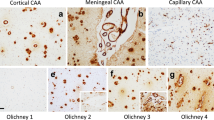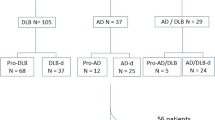Abstract
To elucidate whether the apolipoprotein E ɛ4 allele (APOE4) affects cortical neuropathology in Parkinson’s disease (PD), we determined APOE genotypes and quantified the densities of cortical Lewy bodies (LBs), amyloid plaques and neurofibrillary tangles in 22 autopsy-proven PD cases (12 with dementia; 10 without dementia) that were not accompanied by Alzheimer’s disease. The APOE4 frequency in the demented patient group was 0.21, which was significantly higher than that in Japanese controls (P < 0.04). LB densities in demented PD patients were significantly higher than those in non-demented PD patients, despite the shorter disease duration in the former. Moreover, plaque density in the temporal cortex and LB density in the cingulate cortex were significantly higher in the group with APOE4 than in that without the allele. There was no difference in tangle density between these two groups. These results suggest that APOE4 may influence the increase in the number of cortical LBs and amyloid plaques in PD. It is possible that when PD occurs in individuals with APOE4, concomitantly evolving cortical LB pathology in a proportion of cases results in limbic (transitional) or neocortical-type LB disease.
Similar content being viewed by others
Author information
Authors and Affiliations
Additional information
Received: 11 August 1997 / Revised, accepted: 31 November 1997
Rights and permissions
About this article
Cite this article
Wakabayashi, K., Kakita, A., Hayashi, S. et al. Apolipoprotein E ε4 allele and progression of cortical Lewy body pathology in Parkinson’s disease. Acta Neuropathol 95, 450–454 (1998). https://doi.org/10.1007/s004010050824
Issue Date:
DOI: https://doi.org/10.1007/s004010050824




